Canon EF 28 mm f/2.8 IS USM
3. Build quality and image stabilization
The Canon EF 28 mm f/2.8 IS USM, despite having the focal length bigger than the EF 24 mm f/2.8 IS USM MODEL, is physically a bit smaller. Still, its weight and dimensions remain quite significant, taking into account its parameters. In this class of equipment some companies construct pancake-type devices with great success and the tested Canon evidently doesn’t belong to that group of lenses. Its dimensions can be properly assessed looking at the photo below where the Canon is positioned next to the 2.8/24 and the 1.4/50 models.
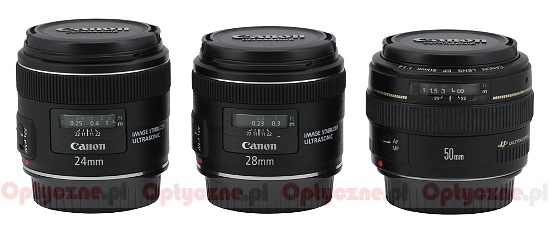 |
Please Support UsIf you enjoy our reviews and articles, and you want us to continue our work please, support our website by donating through PayPal. The funds are going to be used for paying our editorial team, renting servers, and equipping our testing studio; only that way we will be able to continue providing you interesting content for free. |
- - - - - - - - - - - - - - - - - - - - - - - - - - - - - - - - - - - - - - - - - - - - - - - -
Additionally the photo below shows how the Canon 2.8/28 compares with the Nikkor which has the same focal length but a much faster f/1.8 aperture.
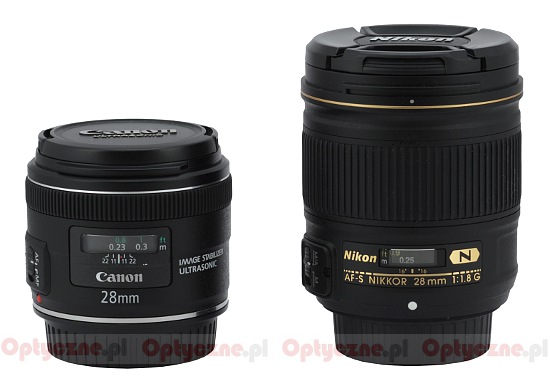 |
When you take the tested lens into your hand you don’t get an impression you deal with an instrument with too much plastics. Here the Canon differs from the Nikkor 1.8/28 in a very positive way because the Nikkor definitely seems completely plastic. When you compare the weight of those two that impression will be confirmed – the Nikkor is significantly bigger, faster, with more optical elements and just 60 grams heavier than the Canon.
The tested lens starts with a metal mount which surrounds a plastic bottom with contacts. A rear element, 18 mm in diameter, moves during focusing. It is situated almost on the same level as the mount when the focus is set at infinity. When you pass to the minimum focus the element hides inside the barrel over 0.5 cm deep. The interior of the lens is revealed then, but it is very well darkened, without any electronic parts visible. It’s worth noticing that when the rear element moves, the front element remains immobile so during focusing the whole optical system of the lens is changing its position, along with its effective focal length.
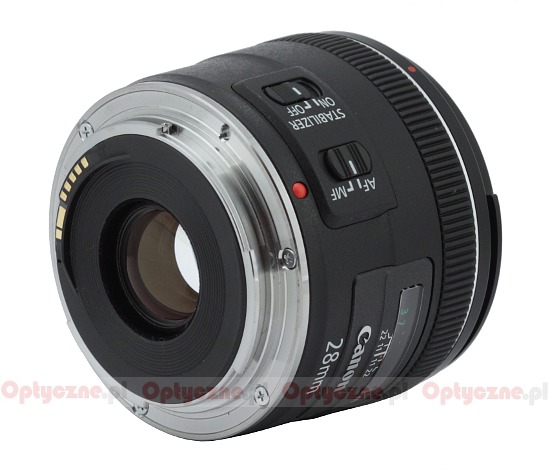 |
Passing onto the proper casing, covered by black plastics, first you meet an inscription stating the focal length value (28 mm) and, on the left, a red dot which makes the alignment with a camera easier. Right next to it there are switches controlling focusing modes (AF/MF) and managing the optical stabilization (STABILIZER ON/OFF). Turning the lens further you can find its serial number and a piece of info that it was made in Japan.
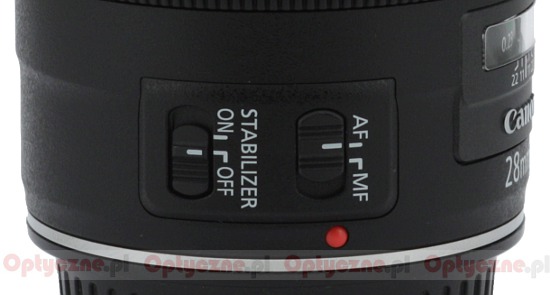 |
Over the „28 mm” inscription you get a clear distance scale expressed in meters and feet, set behind a window; underneath there is a depth of field scale presented for f/22 and f/11 aperture values.
The next element is a rubberized and ribbed manual focus ring. It is almost 9 mm wide and its work is beyond reproach – the moves are smooth and well-damped - you can only complain about its width. A wider ring (13 mm) of the 24 mm model was a bit more comfortable to operate. Running through the whole scale needs a turn through 90 degrees.
Immediately behind that ring there is a thin silver stripe and the lens ends right behind it. On the end there is a hood thread (as always with a Canon you won’t get a hood included in the box, it must be bought separately) which surrounds an immobile filter thread, 58 mm in diameter. The front element is 42 mm in diameter and around it you can find a part of the lens with its name and basic parameters.
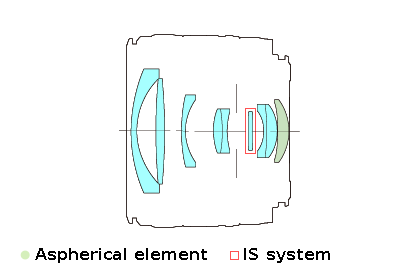 |
The Canon EF 28 mm f/2.8 IS USM consists of 9 elements, one of them aspherical, positioned in 7 groups. Inside the construction you can also find an aperture with seven diaphragm blades which can be closed down to the value of f/22. The producer also boasts of using Super Spectra coatings which are supposed to ensure high transmission and less ghosting and flare.
Buyers get just the caps in the box. Such frugality is, unfortunately, typical for Canon. It’s a pity because at this price point some producers can add also a hood and a case in their accessory kit.
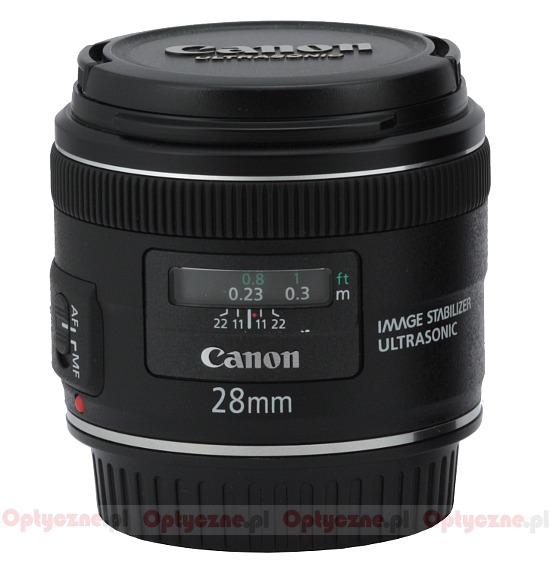 |
Image stabilization
In its newest optical constructions the Canon company boasts of using stabilization as effective as 4 EV. Such a value is reached by the best and the most expensive lenses, though. Let’s check how the Canon 2.8/28 IS fares here.
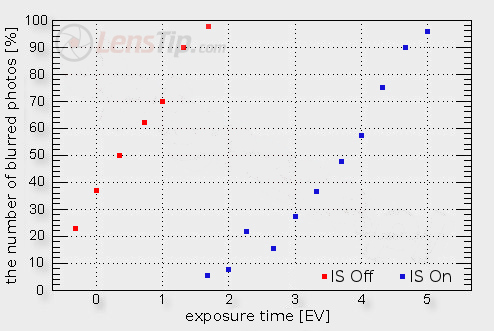
The graph above shows the percentage of fuzzy photos in relation to exposure ratio, expressed in EV (and 0 EV is the equivalent of the 1/25 of a second). The red dots show the results we got with the stabilization off, the blue dots – with the stabilization on. The maximum distance between both curves shows the efficiency of the stabilizing system. In this case it amounts to 3.5 EV which is a very good result the tested lens should be praised for.






